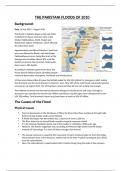Class notes
IB Geography Freshwater Case Studies and Notes
- Course
- Institution
- Book
Detailed notes on all the IB Geography Option A: Freshwater case studies needed for essays, exams and other assignments. Covers impacts, scale, post-event management and causes of different flood events as well as synthesised research into watershed initiatives and manging freshwater. Important fa...
[Show more]




